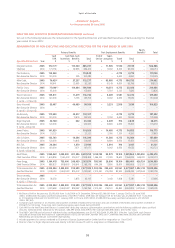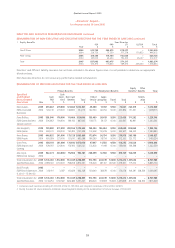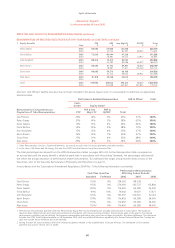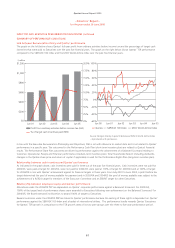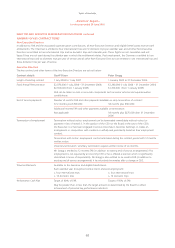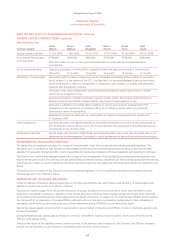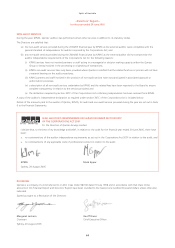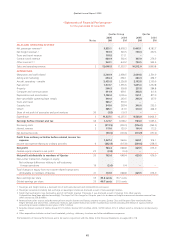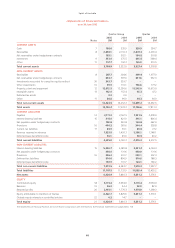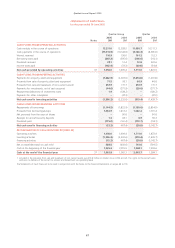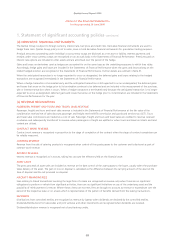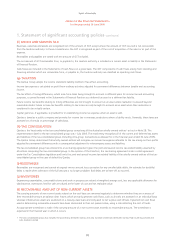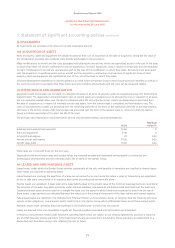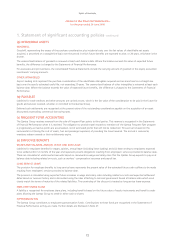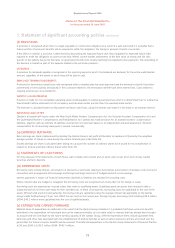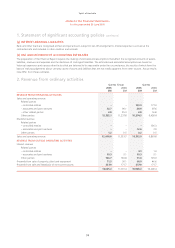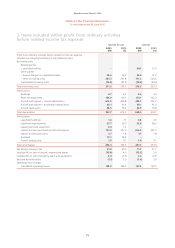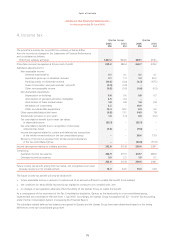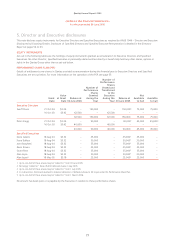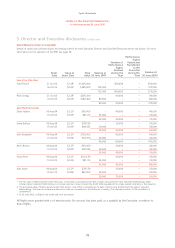Qantas 2005 Annual Report Download - page 70
Download and view the complete annual report
Please find page 70 of the 2005 Qantas annual report below. You can navigate through the pages in the report by either clicking on the pages listed below, or by using the keyword search tool below to find specific information within the annual report.68
Spirit of Australia
~Notes to the Financial Statements~
for the year ended 30 June 2005
1. Statement of significant accounting policies
The significant accounting policies which have been adopted in the preparation of this Financial Report are:
(a) BASIS OF PREPARATION
The Financial Report is a general purpose financial report which has been prepared in accordance with Accounting Standards, Urgent
Issues Group Consensus Views, other authoritative pronouncements of the Australian Accounting Standards Board (AASB) and the
Corporations Act.
This Financial Report has been prepared on the basis of historical costs and, except where stated, does not take into account changing
money values or fair values of assets.
These accounting policies have been consistently applied by each entity in the Qantas Group, being Qantas Airways Limited (Qantas) and
its controlled entities and are consistent with those of the prior year.
Where necessary, comparative information has been reclassified to achieve consistency in disclosure with current financial year amounts
and other disclosures.
(b) PRINCIPLES OF CONSOLIDATION
CONTROLLED ENTITIES
The Qantas Group Financial Statements comprise the Financial Statements of Qantas and the Qantas Group. Results of controlled entities
which were acquired or disposed of during the year are included in the Statements of Financial Performance from the date control
commenced or up to the date control ceased. The consolidation process eliminates balances and transactions with or between Qantas and
its controlled entities. Outside interests in the equity and results of controlled entities are shown as a separate item in the Qantas Group
Financial Statements.
ASSOCIATES AND JOINT VENTURES
Associates and joint ventures are those entities over which the Qantas Group exercises significant influence or joint control and which are
not intended for sale in the near future.
Investments in associates and joint ventures are accounted for using equity accounting principles. Investments in associates and joint
ventures are carried at the lower of the equity accounted amount and recoverable amount. The Qantas Group’s equity accounted share
of the net profit of associates and joint ventures is recognised in the consolidated Statement of Financial Performance from the date
significant influence or joint control commenced, up to the date significant influence or joint control ceased.
(c) FOREIGN CURRENCY TRANSACTIONS
Foreign currency transactions, except those subject to specific hedging arrangements, are translated to Australian currency at the rates
of exchange ruling at the date of each transaction. At balance date, amounts receivable and payable in foreign currencies are translated
at the rates of exchange ruling at that date. Resulting exchange differences are brought to account as exchange gains or losses in the
Statements of Financial Performance in the financial year in which the exchange rates change.
TRANSLATION OF CONTROLLED FOREIGN ENTITIES
All controlled entities incorporated overseas are self-sustaining foreign operations and as such, their assets and liabilities are translated
at the rates of exchange ruling at balance date. Equity items are translated at historical rates. The Statements of Financial Performance
of controlled foreign entities are translated at the average exchange rate for the year. Exchange differences arising on translation are
recorded in the foreign currency translation reserve. The balance of the foreign currency translation reserve relating to a controlled entity
that is disposed of, or partially disposed of, is transferred to retained profits in the year of disposal.
HEDGING OF FOREIGN CURRENCY COMMITMENTS
Gains and losses on derivatives used to hedge the specific purchase or sale of capital equipment and goods and services are deferred in
the Statements of Financial Position and included in the measurement of the related purchase or sale. Net deferred gains/losses associated
with hedges of foreign currency revenue relating to future transportation services are included in the Statements of Financial Position as
payables/receivables. These gains/losses will be included in the measurement of the relevant future foreign currency revenue at the time
the transportation services are provided. As at 30 June 2005, net deferred gains were $228.4 million (2004: losses $19.2 million).
Revenues and expenses from cross-currency swap transactions and amounts owing to/from swap counterparties are set-off and disclosed
on a net basis where the requirements of AASB 1014 – Set-off and Extinguishment of Debt are satisfied.


